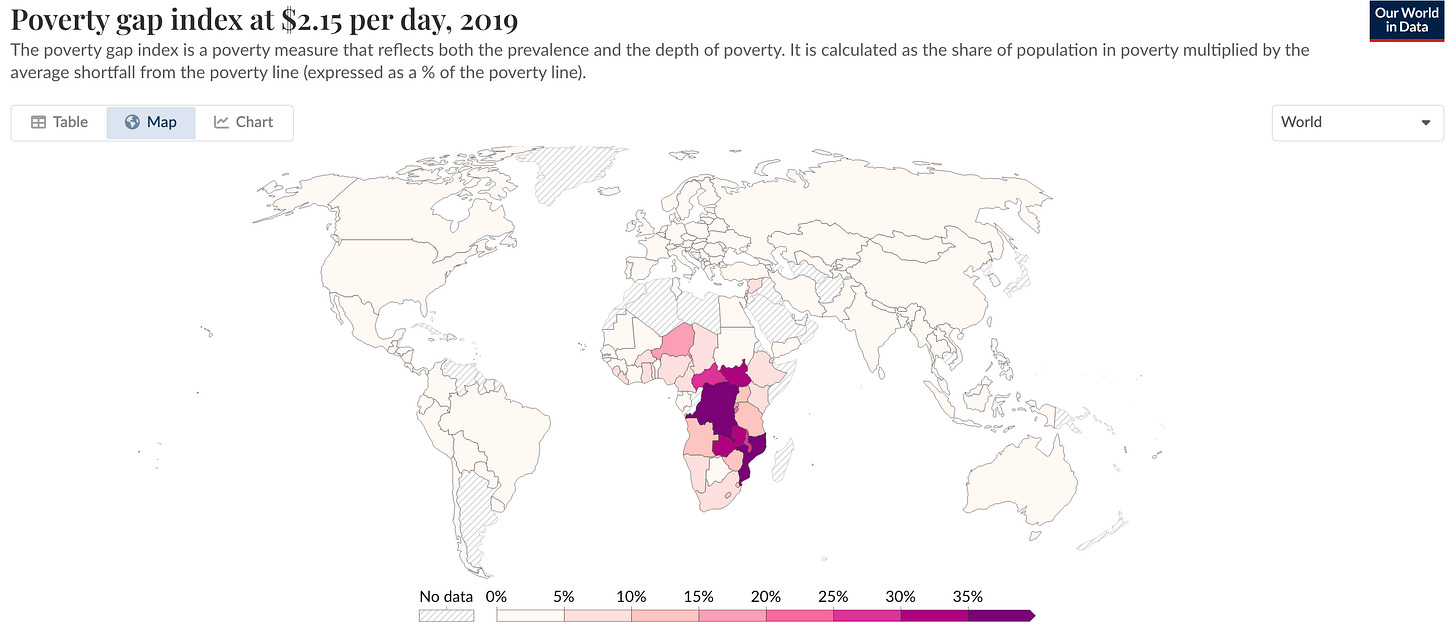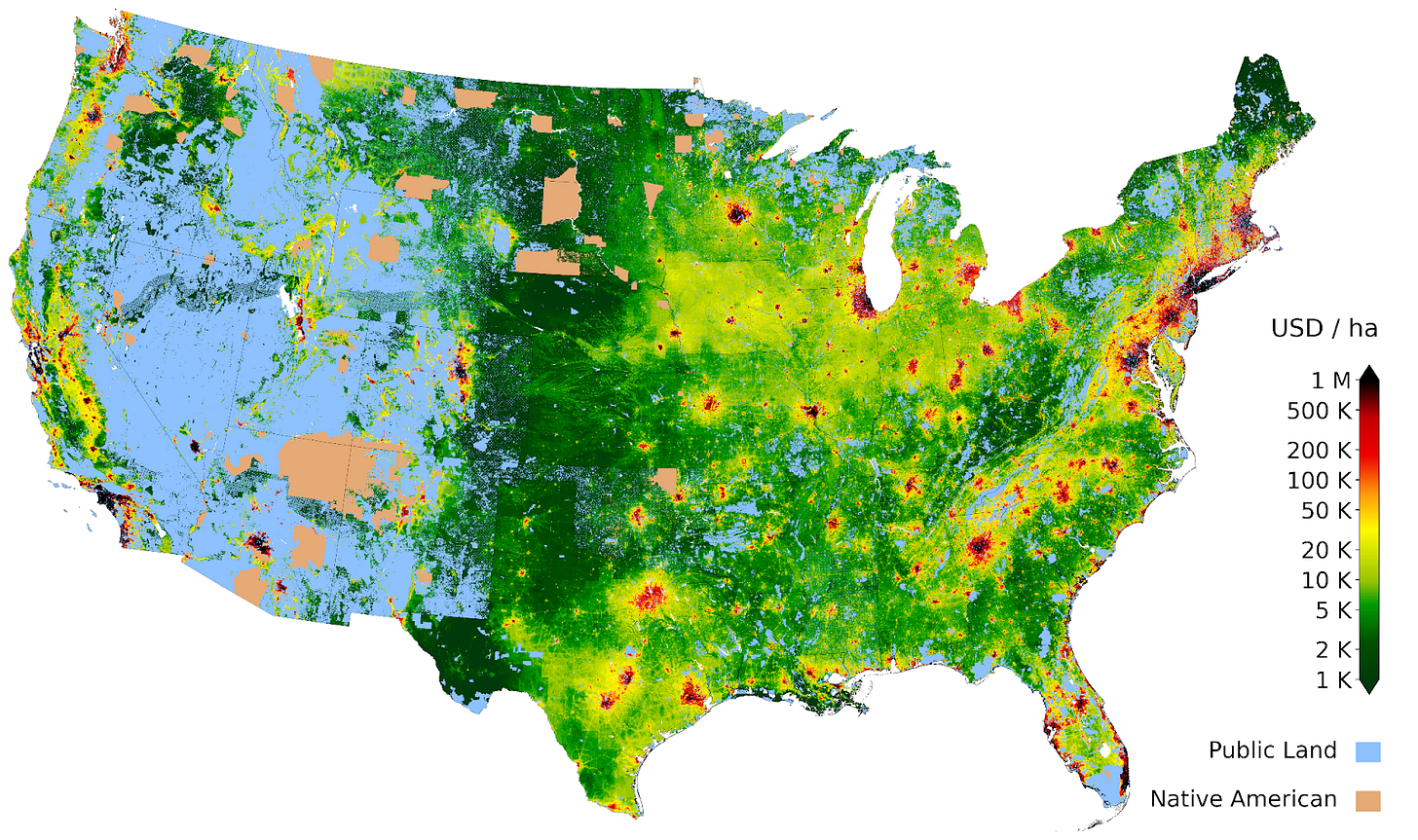1.
I love obscure blog posts. Sometimes they pose a question nobody else is asking, like Should we prioritise cash transfers to the urban poor?
If you give money to the poorest person in a remote village, the paper money isn’t changing anything about the productivity of the village, so just give one particular person more purchasing power relative to their neighbors. That shifts consumption from one poor person to one very poor person. But if the village is connected to the global economy, the transfer is much more effective.
There’s only a handful of globally integrated cities with a high prevalence of extreme poverty. The majority of the world’s extreme poverty will be located in sub-Saharan Africa in the coming decades due to slow economic growth and higher fertility. The Abidjan-Lagos corridor and Kinshasa probably top the list:

Coincidentally, there are charities that offer conditional cash transfers to people who move to the city. Taking a job in the city usually means higher pay and an uncorrelated income source for family back home. But moving requires money to cover the trip and the absorb the opportunity cost. There’s no guarantee you get a job once you reach the city. The conditional cash transfer can ameliorate these risks and make visiting the city a clear win.
EDIT: see also Urbanization Passes the Pritchett Test.
2.
This project measuring land values has a lovely map:
It’s a great illustration of where the revenue for a land value tax would come from. The black regions are 1000x more valuable per unit area than the dark green areas. Plus, land is a larger fraction of the property value in urban areas. There are also fewer landowners in the dark green areas. The end result is that most of the revenue from an LVT is would come from from metropolitan areas.
I used plot digitizer to measure the area of the most valuable region around Minneapolis and got an estimate of 600 sq. miles. Scaled up 1000x, that’s 20% of the area of the continental US. There are dozens of cities like Minneapolis.
Though the vast majority of economic activity is happening in cities, consider the symbiotic relationship they have with rural land. Cheap land ensures low prices for crops like wheat, corn, and soy, which feed the cities. Cities in turn produce innovations that make farming more efficient, such as laser weeding machines.
As AV’s make urban agglomerations larger, demand for rural land will fall, making food slightly cheaper. More importantly, larger cities are more innovative, and will find other ways to increase yields and lower costs.
Some innovations I’m excited about include automated farming equipment, self-driving trucks, genetically modified crops, on-site fertilizer production, long-term weather forecasting, and crop futures.
3.
Comparative prospects of imaging methods for whole-brain mammalian connectomics. This made me realize that electron microscopy cannot scale. The semiconductor industry has been unable to scale e-beams and connectomics won’t either. The path forward is through expansion microscopy, PRISM, and much cheaper light microscopes.
On that front, Triplet Imaging appears to be a new technique for imaging biological samples. This may lead to cheaper light microscopy of neurons. Recent Advances in Lensless Imaging reviews academic work to image without needing expensive lenses and optical systems. However, there’s still a long ways to go before this can replace traditional optics and it may never get there. The authors on that last paper have a lot of interesting work. See Laura Waller’s page for example.
Dramatically improve microscope resolution with an LED array and Fourier Ptychography. One of many tricks to increase the resolution of light microscopes and stacks well with the techniques above.
What’s exciting about this confluence of work is that if every component of the imaging system is a piece of semiconductor equipment, the magic of enchippening kicks in. All of the sudden, we can scale production and use more computation to image brains for cheaper. Moore’s law for Em’s.
EDIT see also: Infrared quantum ghost imaging of living and undisturbed plants.
Everything else
While looking into point 3, I found some papers on using a wide field image of the sky to predict solar output for that day so the grid can adjust:
Computational Imaging for Long-Term Prediction of Solar Irradiance
Precise Forecasting of Sky Images Using Spatial Warping
Imagine combining this with long term weather forecasting, weather satellites, and simulations to optimize the grid.
Luminous Robotics is building robots to help crews install solar panels faster. EDIT: Maximo seems to be a similar product.
Gerrit Bruhaug has a short thread on why nuclear reactors at sea aren’t a good way to produce naval fuel.
Undersea nuclear forces: Survivability of Chinese, Russian, and US SSBNS. Technological advances are likely to increase the survivability of nuclear submarines on net. I breathed a sigh of relief reading this because nuclear submarines are our main nuclear deterrent. Even if you destroyed the U.S., a single Ohio-class submarine can drop almost 80 nuclear warheads on an attacking nation. And they’re extremely difficult to find. And there are 14 of them. Keeping them hidden maintains MAD.
Can 1B LLM Surpass 405B LLM? Rethinking Compute-Optimal Test-Time Scaling
Prime Intellect is a decentralized compute marketplace as well as an effort to train and inference large AI models in a decentralized manner. Very cyberpunk.
The True Power of AI Deepfakes Is Not What You Think. See also my thread on this topic and some resources on propaganda here and here.
Frequently Asked Questions About US Government Funding for R&D. The U.S. should spend much more on science.
Moral Hazard and the Sustainability of Income-Driven Repayment Plans. ISA’s don’t appear to be workable given the moral hazard issues. That leaves us with flat rate loans unless there was some hard-to-fake measure of potential available. EDIT: see also Genes as Tags: The Tax Implications of Widely Available Genetic Information.
Good Kurzgesagt video about the cost to make factory farming much more ethical. It would raise costs by ~10% for beef and milk, 50% for pork and eggs, and 100% for chicken. In lieu of a better solution to factory farming, those costs seem reasonable. Who should pay it? Should government require these farming practices, or should they be subsidized? I lean towards the latter, particularly because domestic regulations will drive factory farming to unregulated countries.
I’m currently reading Why Not Parliamentarism? See also this 2015 Matt Yglesias piece advocating for a parliamentary system and this post on Risk & Progress. Parliaments with proportional representation, fixed terms, and term limits make the most sense to me.
Longtermist implications of aliens Space-Faring Civilizations





While advancements in solar technology are crucial for enhancing energy production accuracy, the most significant gains in renewable energy efficiency may come from improving wind output predictions. Wind turbines are particularly sensitive to variations in wind speed; even a modest increase from 10 to 12 mph can result in a 30 percent change in power output. This level of precision in wind speed estimation was not as critical before the advent of wind power.
The unpredictability of wind patterns poses a significant challenge for the financing of wind turbines. Inconsistent output predictions make it difficult for investors to accurately forecast revenue, thereby complicating the financial viability of wind energy projects. This uncertainty underscores the need for more robust research and development in wind forecasting technologies.
By enhancing our ability to predict wind patterns with greater accuracy, we can stabilize energy outputs, improve the reliability of wind turbines, and ultimately make wind energy a more attractive and financially viable option. Investing in this area of research is essential for maximizing the potential of wind power and advancing the broader goals of renewable energy integration.